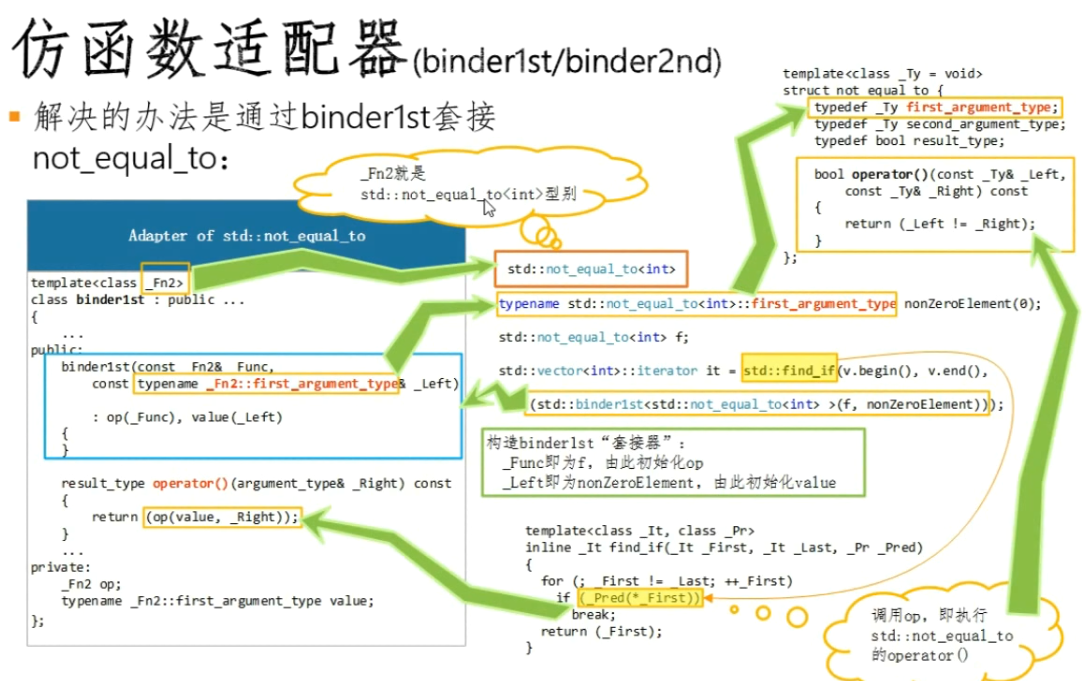C++ 仿函数和适配器
本文从不断复杂的应用场景入手,来说明C++设计仿函数和适配器的原因,并深入源码来介绍仿函数和适配器的使用方法。
仿函数
现有一个vector
使用std::count_if,代码可能长这个样子。
bool greaterThan8(int n){
return n > 8;
}
int count = count_if(vec.begin(), vec.end(), greaterThan8);
count_if第三个参数接收的是一个函数指针,并且这个函数指针只接收一个参数,返回值是bool。
count_if是将参数1和参数2之间的每一项都会作为参数去调用第三个参数,然后返回第三个参数每一次true的次数。
这里是将8直接写在这里,并不符合编程规则,也不容易维护。
或者新加个参数
bool greaterThanN(int n, int x){
return n > x;
}
看起来可以解决问题。
但是上文说了,count_if的第三个参数函数指针,只能接收一个参数。
如何取消这个参数呢?
1、全局变量
int minValue = 8;
bool greaterThanN(int n){
return n > minValue ;
}
能解决问题,但是并不优雅。
1、容易出错
为什么这么说呢,我们必须先初始化maxLength的值,才能继续接下来的工作,如果我们忘了,则结果未定义。
此外,变量maxLength和函数LengthIsLessThan之间是没有必然联系的,编译器无法确定在调用该函数前是否将变量初始化。
需要使用者自己控制,则增加维护成本和出错可能性。
2、没有可扩展性
如果我们每遇到一个类似的问题就新建一个全局变量,尤其是多人合作写代码时,很容易引起命名空间污染(namespace polution)的问题。
3、全局变量的问题
全局变量花销很大,一般是编程过程中极力避免的
- 宏
\#define VALUE 8
bool greaterThanN(int n){
return n > VALUE;
}
换成宏是节省了全局变量的代价。但是依然不够优雅,容易出错且可扩展性差。
3.成员变量
我们既想要它既能想普通函数一样传入给定数量的参数,还能存储或者处理更多我们需要的有用信息。
如果存成成员变量,那成员函数调用不就是很正常的事了吗?
对,为了实现上面的内容,C++语言引入了仿函数的概念。
仿函数(functor),其实是像函数一样使用的对象,也被称为函数对象(function object)。仿函数里面重载了"()"操作符,是我们可以像调用函数一样调用它。
仿函数的基本使用
class functor {
public:
functor(int x) { value =x; }
void operator()(const int& x) { cout << x+value << endl;}
private:
int value;
};
functor fun(10);
fun(5); //15
为了满足文初的应用场景,使用仿函数的代码,大概长这样
template<typename T>
class greater{
public:
greater(const T&x) { info = x; }
bool operator()(const T& x) { return info > x; }
private:
T info;
};
调用代码
greater<int> ge(20);
int count = count_if(vec.begin(), vec.end(), ge);
或者直接使用临时变量
int count = count_if(vec.begin(), vec.end(), greater<int>(20));
当然,这里可以不用模板,但是为了扩展和方便,建议还是养成用模板的习惯。
另外,不用普通函数指针是因为函数指针的局限:
- 不能满足STL的抽象要求
参数,返回值如何设置 - 无法和STL其他组件交互
template<typename _Kty, typename _Pr = less<_Kty>,...>
class set{...};
class Person{...};
std::set<Person, std::less<Person> > set1, set2; //operator<做排序行为
std::set<Person, std::greater<Person> >set3,set4;//operator>做排序行为
set1 = set2; //正确,相同的型别
set1 = sete3; //错误,不同的型别!
STL中也预先实现了一些仿函数,需要包头文件#include<functional>
另外在c++11里面可以通过lambda表达式解决上述问题:
#include <vector>
#include <iostream>
#include <algorithm>
#include <functional>
using namespace std;
int main()
{
std::vector<int> c{ 1, 5, 3, 4, 5, 6, 7 };
int x = 5;
int k=std::count_if(c.begin(), c.end(), [x](int n){return x == n; });
cout << k << endl;
return 0;
}
适配器
bind1st/bind2nd
vector<int> vec{0,0,0,10};
怎么找到第一个非0元素?
通过std::not_equal_to,代码应该是下面这样
std::vector<int>::iterator it = std::find_if(vec.begin(), vec.end(),
std::not_equal_to<int>(0));
无法通过编译。为什么?
not_equal_to结构没有一个参数的构造函数not_equal_to的operator()需要接受两个参数
template<class _Ty = void>
struct not_equal_to
{ // functor for operator!=
typedef _Ty first_argument_type;
typedef _Ty second_argument_type;
typedef bool result_type;
_CONST_FUN bool operator()(const _Ty& _Left, const _Ty& _Right) const
{ // apply operator!= to operands
return (_Left != _Right);
}
};
现在,这里需要一个插座,也就是适配器模式里的适配器。
typename std::not_equal_to<int>::first_argument_type nonZeroItem(0);
std::not_equal_to<int> f;
std::vector<int>::iterator iter = find_if(vec.begin(), vec.end(),
std::binder1st<std::not_equal_to<int> >(f, nonZeroItem));
具体调用如下

使用f, nonZeroItem来构造std::not_equal_to<int>类型的bind1st。operator()实际上调用的是std::not_equal_to<int> 的operator()。

为了方便使用,std使用bind1st进行了封装
template<class _Fn2,
class _Ty> inline
binder1st<_Fn2> bind1st(const _Fn2& _Func, const _Ty& _Left)
{ // return a binder1st functor adapter
typename _Fn2::first_argument_type _Val(_Left);
return (binder1st<_Fn2>(_Func, _Val));
}
那我们的代码应该会变成这个样子
std::vector<int>::iterator iter = find_if(vec.begin(), vec.end(),
std::bind1st(std::not_equal_to<int>(), 0));
binder2nd和binder1st类似。区别只在于_Func操作的是左值还是右值。
也就是说以下两句代码的同义的
std::vector<int>::iterator iter = find_if(vec.begin(), vec.end(),
std::bind1st(std::less<int>(), 0)); //std::bind2nd(std::greater<int>(), 0)
std::vector<int>::iterator iter = find_if(vec.begin(), vec.end(),
std::bind2nd(std::greater<int>(), 0));
bind1st操作的是左值,找到第一个X,使满足0 < X
bind2nd操作的是右值,找到第一个X,使满足X > 0
mem_fun/mem_fun_ref
设计和上面类似,是用于适配对象的函数
需求:打印vector中所有Person类的成员
std::vector<Person*> vec;
vec.push_back(new Person("I",1));
vec.push_back(new Person("love", 2));
vec.push_back(new Person("u", 3));
vec.push_back(new Person("so much", 4));
std::for_each(vec.begin(), vec.end(), &Person::Print); //编译不通过
如何能在函数中调用对象的成员函数呢?
首先,有对象obj,和函数fun,调用方法有如下几种:
1. fun(obj) //fun是全局函数,非成员函数
2. obj.fun() //obj非指针,fun是成员函数
3. obj->fun() //obj指针对象,fun是成员函数
for_each会调用_For_each
只接收fun(obj)的调用

所以代码应该是下面这个样子
std::for_each(vec.begin(), vec.end(), std::mem_fun(&Person::Print));
具体调用

mem_fun_ref类似,但是用于容器中存放的不是指针的情况
释放内存
方法一
for (vector<Person*>::iterator it = vec.begin(); it != vec.end(); ++it)
delete (*it);
vec.clear();
方法二
struct DeleteItem {
template<typename _Ty>
void operator()(const _Ty p) const
{
delete (p);
}
};
std::for_each(vec.begin(), vec.end(), DeleteItem());
vec.clear();
注意
1、有继承的情况下,容器存放指针而不是对象
- 对象拷贝比指针拷贝对象大得多
- 父对象的容器存放子对象时,数据会Slice
2、使用指针记得释放内存
3、尽量用算法代替手写循环
代码更优雅,据说速度更快,但是还没测试过





